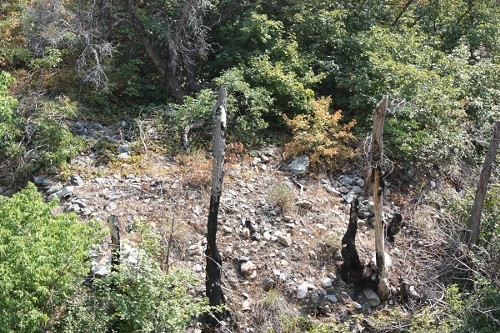Here are two true tales about the sometimes sneaky nature of fire. The first: When the Rainbow Gathering came to Utah in 2003, thousands of people made their way to a remote area of the forest. It was a dry year. Everyone was warned to be sure campfires were totally extinguished before leaving them. Whoever left one particular fire had tried to do that, throwing dirt on embers and scattering them. But inside one of those charcoaled branches, embers still glowed.
The branch smoldered for hours, until the day’s gusty winds blew it onto nearby strands of dry grass. Within minutes, fire erupted. Luckily, the thin plume of smoke was quickly noticed, and a crowd stomped and threw dirt and water on the fire until it was truly out.
The second story: I’d lit a large chunk of wood in my fireplace, but instead of a blazing fire, the log just charred and went out. I left the blackened wood in the fireplace. It was still there the next day. In the middle of the following night, I woke up coughing and choking. The whole house was filled with blinding smoke. I couldn’t even see the glowing alarm clock.
In a daze, I rushed through the rooms, looking for the source. It was the log. After smoldering internally for almost 30 hours, it had burst into flickering orange embers, emitting clouds of smoke. I grabbed the hose from outside and doused it, but it took a long time for the smoke odor to vanish.
Few people know that wood can smolder for days. Slater Wayment, the camping supervisor at REI in Salt Lake City, says, “Any time hot embers are well insulated, they’ll retain their heat. When re-exposed to oxygen, they can burst out in flame. I would expect that’s what happened in your fireplace. The fireplace insulated the wood.”
There’s been a perfect storm of fire conditions throughout the Intermountain West this summer. Hot air, low humidity and dry vegetation have allowed mere sparks to quickly flash into massive fires. Wayment says even carelessly tossed live cigarette butts can cause a fire. “In a couple of instances, vehicles started fires,” he says. “The cars were pulled off on the shoulders of the road, where there was dry grass. A car has really hot parts underneath and can easily ignite dry grass.”
Surprisingly, according to Forest Service spokesman Loyal Clark, many of the strict fire limitations in effect for the past months have been lifted. “We make weekly checks of the vegetation, such as sagebrush, oak brush and grass. We take readings to see how much moisture they contain. The recent rainstorms have elevated the moisture content, so the danger isn’t as high.”
That means that, as of press time, backpack stoves and open fires are permitted in certain areas. Still, it’s always best to call the Forest Service to check current conditions and restrictions of where you’re planning to camp. A Public Lands Information Center (801-466-6411) is located inside the Salt Lake REI store.
While none of this summer’s massive wildfires was started by neglectful campers, Clark says it’s always important to be sure any wilderness campfire is really out. “Put sufficient water or dirt on it to make sure it’s extinguished,” she says. “Then actually put your hands above where your fire has been and make sure it’s cool to the touch.”
Wayment warns to make sure to avoid “ignition sources” when camping: “You have to have fuel, oxygen and heat to start a fire. In the backcountry, the fuel and oxygen are already there. The only thing lacking is a source of ignition.”
But if you are suddenly caught in a flash fire, remember that flame moves astonishingly fast. “I would generally move into the wind and down slope,” he advises. “I’d move as quickly and safely as the terrain allows, but you don’t want to make a mistake and break your leg. If there’s a lake or river nearby, you can move into the water.”
He also says to alert emergency personnel as quickly as possible, adding, “You have a responsibility both for your own safety and as a steward of the land. In the wilderness, be careful—and remember that your actions affect others.”
More by Wina Sturgeon
-
Conquer the Superpipe
Some advice to help you take the plunge
- Jan 8, 2013
-
Park City Shortcuts
Bypass the traffic and be on your way
- Dec 24, 2012
-
Ride the Terrain Park
Start learning or polish your skills
- Dec 11, 2012
- More »



